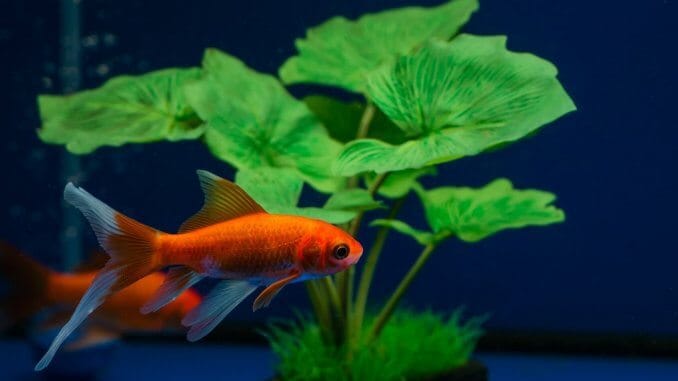
Say hello to one of the most popular breeds of goldfish.
The Comet Goldfish has been with us since the late 1800s and has captivated fish enthusiasts ever since.
Its long forked tail and vibrant color are all good reasons why.
In this article we discuss everything you need to know about them including: how to care for them, expected size, dietary needs, known variations (such as the Sarasa Comet) and much more…
TABLE OF CONTENTS
Comet Goldfish Overview
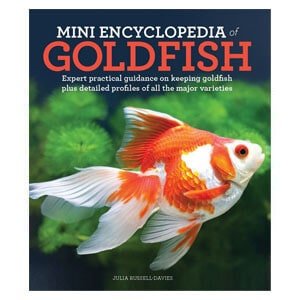
| Category | Rating |
| Care Level: | Easy/medium |
| Temperament: | Peaceful and playful |
| Color Form: | Yellow/orange |
| Lifespan: | 4-14 years |
| Size: | Up to 12 inches |
| Diet: | Omnivore |
| Family: | Cyprinidae |
| Minimum Tank Size: | 50 gallons |
| Tank Set-Up: | Freshwater, cold, planted |
| Compatibility: | Other goldfish varieties |
A Mini Encyclopedia for Goldfish
This detailed guide covers all the different types and colors of Goldfish, how to select them, caring for them, and how to breed them. It’s ideal for beginners and experience hobbyists alike.
The Comet Goldfish, also known as Carassius auratus auratus, has been with us since the end of the 1800s. Hugo Mulertt is credited with the selective breeding program which led to the creation of this fish from wild Prussian Carps.
Since then it has taken the aquarium hobby by storm and this shows no signs of stopping.
They are well received in the hobby because of their hardiness and vibrant colors. A healthy Comet can live up to 14 years old and grow up to 12 in length.
They are traditionally orange/yellow but now due to selective breeding come in a variety of colors.
Typical Behavior
Comets are one of the more active breeds of Goldfish and are very fun to watch. They are fast swimmers and will spend lots of time exploring their surroundings.
Also, contrary to popular belief, they can remember their owners and their tank surroundings and decorations. For this reason you can switch up the decorations in your aquarium every couple of months to keep it interesting for them.
They can become aggressive during feeding, so to help ease this you can place feed at both sides of the tank to reduce competition for food.
Where To Buy Comet Goldfish
Best Comet Goldfish
If you’re looking for a few Comet Goldfish for a large tank or even a pond, you can buy them in groups of between 10 and 200.
Appearance
The Comet Goldfish got its name because of its long flowing golden tail which resembles a comet.
Whilst the common goldfish has ‘stiff’ fins, the Comet has long flowing ones; it is also smaller than ‘regular’ goldfish.
However the main way to differentiate between the two is the Comet’s long heavily forked tail; they have a slim body and only have a tail fin and a single anal fin.
Healthy versions will have normal eyes that are not bulging; their scales should also be flat and not bumpy. It should grow to 12 inches long when kept in a healthy condition.
They can come in a variety of colors with yellow/orange and orange/red being the more traditional colors. However you can also get them in:
- Red and White (Known as the Sarasa Comet)
- White
- Brown
- Yellow
- Black (technically these are a Koi/Comet hybrid)
You can also find them with nacreous (cloud like) coloration and patterning; however these are referred to as Shubunkin goldfish.
Habitat and Tank Conditions
Goldfish Aquarium Cleaner
This cleaner works to naturally break down the organic waste in your Goldfish tank and keeps the gravel clean. It should be used alongside the weekly water change.
You should remember that the Comet Goldfish you see in aquariums today were developed by Hugo Mullert in the 19thcentury.
This means that your Goldfish is a descendant of wild carps known as the Prussian Carp.
It’s therefore important that your aquarium matches the wild habitat of the Prussian Carp. These carp were native to Asia and lived in slow moving bodies of water such as rivers.
They could also be found in lakes, large ponds and ditches that were below the water level.
So how does this translate to your aquarium?
Well first of all in terms of whether to use a pond or tank; it really depends on the number of goldfish you’re getting. Generally if you want to keep more than 4 together, you’re going to need a pond (more on this later).
If you do get an aquarium be sure to get a long rectangular shaped one to provide them with plenty of space to swim in.
For substrate you can use small gravel. In terms of decoration and plants, plants are crucial to oxygenate the water. In addition they provide hiding places to help them feel safe and also act as food for your Comets, as they’ll occasionally nibble the plants. Anacharis, Hornwort, and Java Fern all make ideal candidates.
Tank Conditions
The first thing to note here is that all goldfish require cold water. This means that you should keep your tank away from any heat sources and keep it in a cool room. If you place them in water that is too warm for them it can cause lifelong damage to their nerves.
You should be aiming to keep the water between 50-75°F; meaning that most places in the US will not need any additional heating and the tank will be kept at the right temperature through room temperature.
You should aim to keep the pH level between 6.5 and 7.5.
As for filtration you can’t really over-filter a tank with goldfish in; they produce a surprisingly amount of bio-load which can impact the condition of the water. You can use a hang-on-back filter or if you have the budget a canister filter would be better.
What Size Aquarium Do They Need?
First, you should know that the myth of goldfish only growing to the size of the tank is wrong and incredibly damaging to your fish.
Don’t be fooled by pet shops or anywhere else; it is not suitable to keep them in a small bowl.
They need at least a 50-gallon tank; we would recommend a 75-gallon tank.
How Many Comet Goldfish per Gallon?
As a minimum you should aim for at least 50 gallons per Comet Goldfish.
Tank Mates
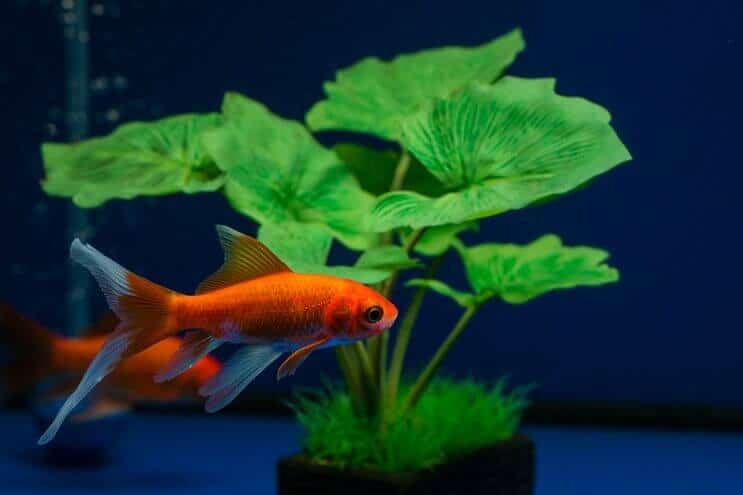 Unfortunately, they don’t make good tank mates, this isn’t because they are aggressive, and it’s due to these two main reasons:
Unfortunately, they don’t make good tank mates, this isn’t because they are aggressive, and it’s due to these two main reasons:
- Although your Pond Comets live in freshwater, they are not tropical. This means you won’t be able to keep them with other popular freshwater fish, as the warm water is too hot for them.
- Second, they tend to consume lots of food, so other fish in the tank are at risk of being malnourished.
For this reason the bulk of options for other tank mates come in the form of other goldfish and koi. We would recommend keeping it simple and keeping them with similar sized varieties such as the Common, Shubunkin, Wakin and Jikin goldfish.
If you are looking to include other tankmates you can look at:
Remember though with any non-goldfish you will be playing a balancing act with the temperature of the tank.
Keeping Comet Goldfish Together
You can keep multiple Comet Goldfish together in a single tank but the biggest problem you’re going to have is size. As mentioned above each Comet needs at least 50 gallons, so if you’re planning on keeping 4 of them you’re going to need a huge 200 gallon tank.
Diet
Best Fancy Goldfish Food
This food has been especially researched and developed to provide your Goldfish with the best possible diet and enhance their coloring and energy levels.
Remember above when we said that they are descendants of Prussian Carp. This means it’s important to understand what they eat in the wild so you can ensure your Comets are getting a wholesome diet.
In the wild Prussian Carp are omnivores; this means they eat both plant and animal matter. In their natural environment they will feed on plants, small insects, algae and anything else they can get hold of; however the majority of their diet is vegetation (this provides them with plenty of fiber).
Generally you can start by feeding your Comets goldfish pellets or flakes. These flakes are manufactured to meet their specific nutritional requirements; however this shouldn’t be their only food source.
If you want your fish to have bright coloration, a varied nutritious diet is crucial. For meat sources you can feed them:
- Small Insects
- Worms
- Bloodworms
- Mosquito larvae
In terms of plants and vegetables you can feed them:
- Mashed Peas
- Algae
- Cucumber
- Carrots
- Zucchini
- Lettuce
- Broccoli
- Fruit (Sliced Blueberries and Strawberries)
You will often see them munching away, and many keepers struggle with knowing how much to feed them.
You should aim to feed them 2-3 times a day and only give them what they can consume in less than 2 minutes. After this, you should remove the remaining food. One common illness with them (bloat) is caused by overfeeding so best to err on the side of caution.
Remember to keep their water temperature up above 50°F, because they will get digestive problems if eating when they are too cold.
Breeding
Unfortunately, it is very difficult to breed them in an aquarium (it’s generally too small for them); instead they need a pond.
It’s also worth mentioning here that you should only keep Comet Goldfish in the pond. If you have other goldfish in there, they could cross breed and create different varieties.
To get them to start spawning they need a trigger. As they are cold-water fish the easiest way to do this is to increase the temperature in their tank/pond. You should keep them in cooler water (58°F) for at least a month and then gradually increase the water temperature until it reaches around 70°F; this will emulate the change in water temperature during spring in the wild.
You will know almost straight away if you’ve been successful as this will trigger spawning behavior. For the male he will chase the female around the pond and attempt to touch her stomach. If successful she will release her eggs (up to 1000 of them) into nearby plants.
We would recommend using a spawning mop; this way once the eggs have been laid you can remove them from the pond and place them in an aquarium. You want to remove the eggs otherwise the parents will eat them.
Leave the eggs in the new aquarium for around a week at 70°F and they will hatch. Within a few days they will start swimming and you will have a new School of Comet Goldfish fry.
Comet Goldfish FAQS
Comet Goldfish Growth Rate
During their first few weeks you can expect your Comet to grow up to 50% each week. It will take them around 3-4 years to reach their full size.
How Big Do Comet Goldfish Grow
They can grow up to 12 inches when fully matured.
Comet Goldfish Lifespan
You should expect them to live from 4 to 14 years. The wide lifespan accounts for the range of common illness which they can experience.
Common Health Problems
Like other Goldfish, the Comet is prone to some common health problems including:
- Ich
- Fin Rot
- Fungal Infections
- Swim Bladder Disease
We will cover these common illnesses and the treatment of them in a future article.
Is the Comet Goldfish Suitable for your Aquarium?
After reading this guide you should know if the Comet Goldfish is the right fish for your aquarium.
They add both a vibrant personality, and bright colors to your tank.
Just remember they will grow to become incredibly large, even though as a youth they can be only 2 inches in size.
Whilst they aren’t demanding to keep, they do require a large tank which generally means that they aren’t suitable for beginners.
Do you keep Comet Goldfish? Let us know your experience with them in the comments section below…

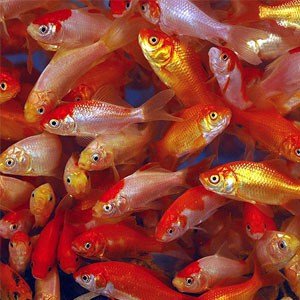
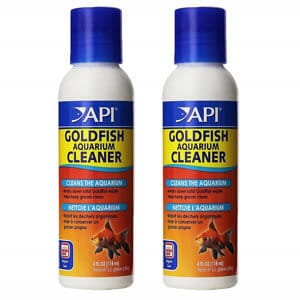
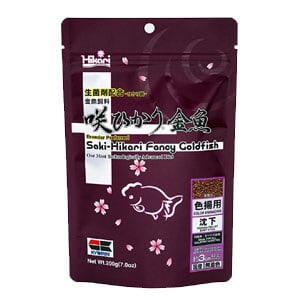
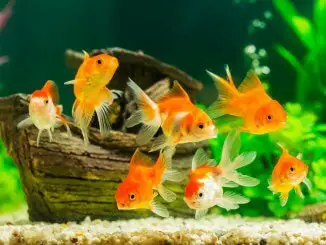
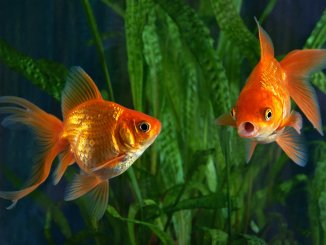
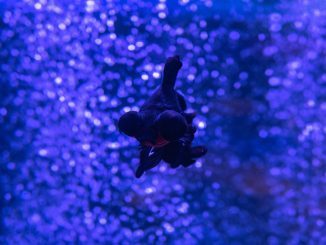
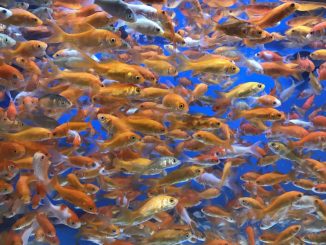
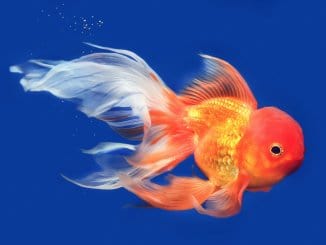
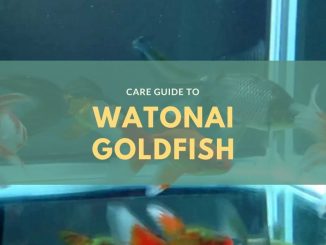
We have 5 comets that we keep in an inground pond in the flower bed. They stay outside year round and are now about 4 years old and I am noticing breeding behavior for the first time. I must confess the first three years I didn’t give them much attention as I was trying to rebuild our home after lightning caused it to burn. They lived in a child’s wading pool without attention.
They’re beautiful fish and apparently very tough.
We have two comets and a common gold fish in a 100 imperial gallon stone trough in the garden. They are two years od and this year four offspring survived being eaten as eggs! The offspring are respectively, gold and white, gold with a couple of black patches and two completely gold. Given the size of the trough it is time to move the small ones to another trough. They do appear quite happy all together i.e. No aggressive behaviour.
I have a 15m X 3m swimming pool, it is 2 foot deep at one end and four foot deep at the other.
It is stocked with dozen of the small mosquito eating fish and has a number of water plants
About a six weeks ago I introduced six comet gold fish, all fine until a week ago when I saw them chasing each other around the pool, two days later one died. This has happened three times now, they chase each other around the pool next day one dead
What is the cause, what am I doing wrong?
there are only a couple of things that i know of that might be happening:
1. the females cannot have sex(basically)and they try-thus killing themselves (this option far more sense if they are descended from the same parents
2. they are males and they fight each other too roughly
I have seen the same behavior, usually larger fish chasing a smaller one until it dies. Would like to understand this.
I never realized I haven’t been treating my goldfish the best, I do not have the space to keep a 50 gallon tank, could a 40 gal. work? I only have two.
My kids have an 8 year old comet in an indoor aquarium. It’s name is Fizzgig. It is now 11 inches with a long, flowing tail approx 1/3 of it’s body. We started in a 10 gallon, and it has outgrown it’s tank twice. We now keep it in a 55 gallon. It has a fantastic personality. It responds instantly to a double finger drag on the glass which means food is coming. It will follow me around the room as I walk, always lingering on the side of the tank I’m at, looking at me. It fluffs, shimmies and parades when my kids put their heads near the glass. It definitely knows who it’s humans are. It is the best fish I’ve ever owned. No other fish can come close to it’s personality or intelligence.
I currently have 1 Comet Goldfish in a 10 gallon tank because I can’t make room for anything bigger until midsummer so is that bad. I don’t know if it can harm him or not but he seems fine and is eating and swimming very well. I just don’t know if there is a limit to how long they can stay in a 10 gallon so that is why I am concerned.
My beautiful comet of 14 years lived his life in a 10 gallon tank and just died two years ago, shortly after finally making room for a 30 gal. I didn’t realize he was butting up against his estimated life span or I may have left him where he was.
And while I thought he was big, the new one in the 30 gal is quickly so much bigger, but I have a second with her that hasn’t grown at the same rate.
As long as it is still small, it should fine until you can upgrade soon. Mine lived in a 10 gal for 10+ years until I got him to my own place, he is now in a 75 but he is permanently stunted.
Can you advise what Bloat is? I have a black comet about 7” long and because he looks kind of big I’m wondering if he has Bloat. He’s 22 years old
I have a question:
I have one Comet fish, she’s 5cm long in a 60×25×25 cm fish tank and I’m using a Roxin 400 led light and a RS 3001 filter, I added decorative rocks and a plastic plant to the water too. I usually feed her once every 3 days, but I read somewhere that I should feed her everyday??
I turn on the filter for one hour and a half everyday, and I keep the lights on for 12 hours a day.
When I turn on the filter, my fish starts running in front of the air and allowing it to push her towards the tank walls. She often goes to ther surface to “breathe” (i think) with the filter still on. She also kinda swims veeery quickly most of the time (in an aimless way sometimes). I also noticed she is putting small decorative rocks inside her mouth and spitting it out. I need to know, is she stressed?? Is she gonna die?? What should I do to help her?
I own 3 Comet Goldfish, I would like to know how big of an aquarium would I need to breed them, I also need to figure out if mine are male or female.
I need to find out if my Comet Goldfish are male or female
I need to figure out if my Comet Goldfish are male or female
Currently I have 3 comet goldfish. I have two that are about 2 inches in a 20 gallon tank and another that is estimated about 4 inches in another 25 gallon tank. I want to put them in the same tank but I’m not sure if they will attack each other.
Hmm, maybe try using a separation net so they can interact and get used to each other. Idk, it’s an idea.
Started with 4 of them now have like 20
I have a beautiful rectangular pond filled with water lilies at my apartment complex here in Bangkok. I estimate it is around 13,000 gallons. There are no pets allowed. I walk past the pretty architecturally designed pond every day for 4 years and have always wanted to sneak some fish into it.
Anyway, about 3 months ago I commenced Operation Fishy Fingers! LOL. I went to my local market an bought a bag of 50 comets that were about 2 inches long. I made sure I came back to the building as it was getting dark. I had the bag of fish inside another bag so the reception staff couldn’t see them.
I snuck in past the CCTV cameras and got my friend to video me quickly emptying the fish into the pond. Ha ha. I came down the next morning and there was one dead fish floating on the surface. For about 2 weeks I could only see 1 or 2 fish. Then I didn’t see any for 2 weeks. Each day I sprinkled some food in. I thought maybe they got sucked into the filtration system.
Then after a month they started darting about. Now I see them every day when I feed them. They are all about 3 inches long and darting about happily. I’m so happy too! Operation Fishy Fingers is a success so far.